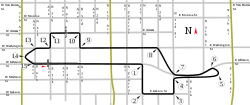Phoenix street circuit
 The track in 1989 and 1990  The track in 1991 |
|
| Location | Phoenix, Arizona, United States |
|---|---|
| Capacity | 40,000 |
| Major events | Formula One |
| 1989 – 1990 | |
| Length | 3.800 km (2.361 mi) |
| Turns | 15 |
| Lap record | 1:31.050 ( |
| 1991 | |
| Length | 3.721 km (2.312 mi) |
| Turns | 15 |
| Lap record | 1:21.434 ( |
The Formula One United States Grand Prix was held on the Phoenix street circuit in Phoenix, Arizona, between 1989 and 1991. It was held in downtown by the Phoenix Civic Plaza and the America West Arena, prior to the introduction of the state's baseball stadium, Bank One Ballpark. The United States Grand Prix lasted in Phoenix for three years, but was inexplicably dropped by Formula One management. There were no further Formula One races in the US until the Indianapolis Motor Speedway first held a Grand Prix in 2000.
The City of Phoenix wanted to promote itself globally and was looking for ideas from local business leaders. In 1987 local businessman Howard Pynn suggested bringing Formula One racing to Phoenix. City officials liked the idea and created the "Phoenix Grand Prix Committee" headed by Howard Pynn and former Long Beach Grand Prix promoter Chris Pook. Chris Pook approached Bernie Ecclestone, then vice president of the Formula One Group, during the 1987 Detroit Grand Prix and pitched the proposal. Bernie Ecclestone liked the idea but said that he was locked in contract with the city of Detroit until 1991. However, in October 1988, Detroit refused to invest money into improving Grand Prix facilities demanded by Ecclestone and decided to run an Indy car event instead of Formula 1 in 1989. On January 13, 1989, the Phoenix City Council headed by mayor Terry Goddard agreed to stage an annual Formula 1 race on a five-year contract. Phoenix City Council also voted to spend $9 million of taxpayers' money on race circuit infrastructure over the 5 years. It was well known to organizers that Phoenix can be very hot during summer, but nonetheless, Phoenix inherited the Detroit race's scheduled slot of June 4, 1989. The city had only 4 months to finish the 2.36 mile long circuit. This required fencing off and repaving the road surface, as well as building grandstands, garages for the pit crew, and other infrastructure. The project was so massive that local media joked that the city looked as if it was preparing for a Soviet invasion.
...
Wikipedia
